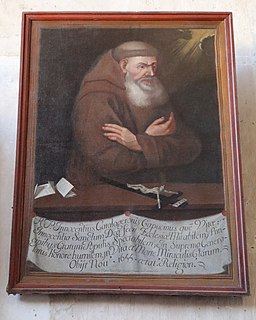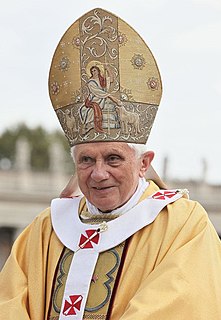
Canonization is the act by which a Christian church declares that a person who has died was a saint, upon which declaration the person is included in the "canon", or list, of recognized saints. Originally, a person was recognized as a saint without any formal process. Later, different processes were developed, such as those used today in the Roman Catholic Church, the Eastern Orthodox Church, Oriental Orthodox Church and the Anglican Communion.

The Venerable Louis-Marie Baudouin was a French Roman Catholic priest who was the founder of the Sons of Mary Immaculate and also the Ursulines of Jesus.
Venerable Francesco Antonio Marcucci was a Roman Catholic Italian bishop and a member of the Secular Franciscan Order. Marcucci was also the founder of the Pious Workers of Mary Immaculate.
Massimo Rinaldi was an Italian Roman Catholic bishop who served as the Bishop of Rieti. He was a member of the Scalabrinians.
Francesco Mottola was an Italian Roman Catholic priest and the founder of the Secular Institute of the Oblates of the Sacred Heart.
Rosa Elena Cornejo Pazmiño was an Ecuadorian Roman Catholic nun who took the name of María Francisca of the Wounds after she became a nun. She established the Franciscan Missionaries of the Immaculata.
José María García Lahiguera was a Spanish Roman Catholic who served as the Archbishop of Valencia from 1969 until his resignation came into effect in 1978. He established the Oblate Sisters of Christ the Priest.

Francesco Marinoni was an Italian Roman Catholic priest who was a member of the Theatines. He assumed the name Giovanni upon admittance into the order.

Blessed Ludwika Szczęsna was a Polish Roman Catholic nun and was also the co-founder of the Sister Servants of the Most Sacred Heart of Jesus which she established with Józef Sebastian Pelczar. She took the name of "Klara" when she became a nun.

Blessed Alcide-Vital Lataste was a French Roman Catholic priest who was a member of the Dominican order. He established the Dominican Sisters of Bethany in 1867 in order to work with women who were abused or from prisons. Their aim was to spread the merciful love of Jesus Christ to these women. He assumed the name of "Jean-Joseph" after he entered the Dominican order.
Blessed Francesco Peleari was an Italian priest and a member of the Society of the Priests of Saint Giuseppe Benedetto Cottolengo. He was a noted preacher and was involved in the work of social services to the poor.

Giuseppe Marcinò was an Italian priest and a member of the Order of Friars Minor - or Capuchins. After he was admitted into the order he selected the new name of "Innocenzo from Caltagirone". He was well known for his frequent and often sensational predications and miracles attributed to him since 1623. Due to this he was granted the moniker of "The Miracle Worker of the Earth".
Amalia Streitel was a German Roman Catholic nun. Streitel established the Sisters of the Sorrowful Mother and assumed the new name of "Maria Franziska of the Cross" after she had become a nun.
Bruno Marchesini was an Italian Roman Catholic seminarian who studied for the priesthood in Bologna, but died before he could be ordained as a priest.

Blessed Maria Therese von Wüllenweber was a German Roman Catholic nun. She established the Sisters of the Divine Savior – also referred to as the Salvatorian Sisters – with the assistance of the priest Venerable Francis Mary of the Cross Jordan, founder of the Salvatorians. She later assumed the name of "Maria of the Apostles" following her solemn profession as a nun.
Blessed Bartolomeo Maria Dal Monte was an Italian Roman Catholic priest who exercised his pastoral mission in his home town of Bologna. He established the Opera Pia Mission as part of the missions.
Blessed Jakov Varingez was a Croatian Roman Catholic professed religious of the Order of Friars Minor. He later assumed the name of "Giacomo of Bitetto" after his profession into that order.
Blessed Luigi Tezza was an Italian Roman Catholic priest and a professed member of the Camillians. He established the Daughters of St. Camillus and is known as the Apostle of Lima. He was ordained in 1864 and went on to serve the sick and the poor in Peru where he administered. Tezza's new religious congregation was established with the sole aim of sick relief who followed the example of the Camillian order as a branch of it.
Armida Barelli was an Italian Roman Catholic who served in the educational field during her life and was also a professed member of the Secular Franciscan Order. Barelli was also the co-founder of the Secular Institute of the Missionaries of the Kingship of Christ. Alongside Father Agostino Gemelli the pair sought to spread the message of the Gospel through their educational facilities and through their congregation that sought also to spread the Franciscan charism.

Blessed Luigi Monza was an Italian Roman Catholic priest and the founder of the Secular Institute of the Little Apostles of Charity. Monza's pastoral mission was defined with catering to the needs of the poor and the sick and used his new congregation as a means of spreading this mission.












